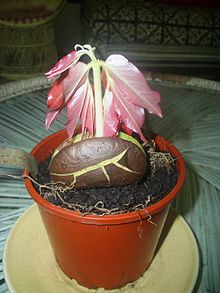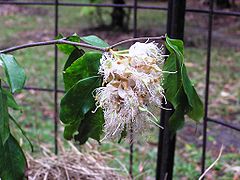- Maniltoa lenticellata
-
Maniltoa lenticellata Scientific classification Kingdom: Plantae (unranked): Angiosperms (unranked): Eudicots (unranked): Rosids Order: Fabales Family: Fabaceae Subfamily: Caesalpinioideae Genus: Maniltoa Species: M. lenticellata Binomial name Maniltoa lenticellata
(C. T. White)Maniltoa lenticellata is a flowering tropical tree in the Fabaceae family. It is native to tropical semi-deciduous rainforest and gallery forests in northern Queensland, some of the Torres Strait Islands, and New Guinea. Common names include: Silk Handkerchief Tree, Cascading Bean, Native Handkerchief Tree.
Maniltoa lenticellata can grow up to 22 m (72 ft) tall but, more commonly, only reaches 10-12 m (33-39 ft). It has compound leaves with 2-4 pairs of leaflets. New leaves are folded inside dull red bracts and then released in a spectacular cascade of white foliage. The fruity-scented flowers which appear in north Queensland in September to October have 3 to 5 white-cream petals, and may be pollinated by marsupials or bats. They produce a brown pod 25-70 mm long by 18-50mm containing one brown seed in November to March. It is a favoured garden tree.[1][2]
"Maniltoa lenticellata var. villosa Verdc. from New Guinea differs from var. lenticellata in having ovaries with dense, persistent hairs." Quoted from: [1]
Footnotes
References
- Beasley, John. (2009). Plants of Cape York: The Compact Guide. John Beasley, Kuranda, Qld., Australia. ISBN 978-0-9806863-0-2.
- Endress, Peter K. and Brigitta Steiner-Gafner. (1996). Diversity and Evolutionary Biology of Tropical Flowers. Cambridge University Press.ISBN 0521565103, ISBN 9780521565103
External links
Categories:- Maniltoa
- Fabales of Australia
- Flora of Queensland
- Trees of Australia
- Flora of New Guinea
- Ornamental trees
- Fabaceae tree stubs
- Australian rosid stubs
Wikimedia Foundation. 2010.


